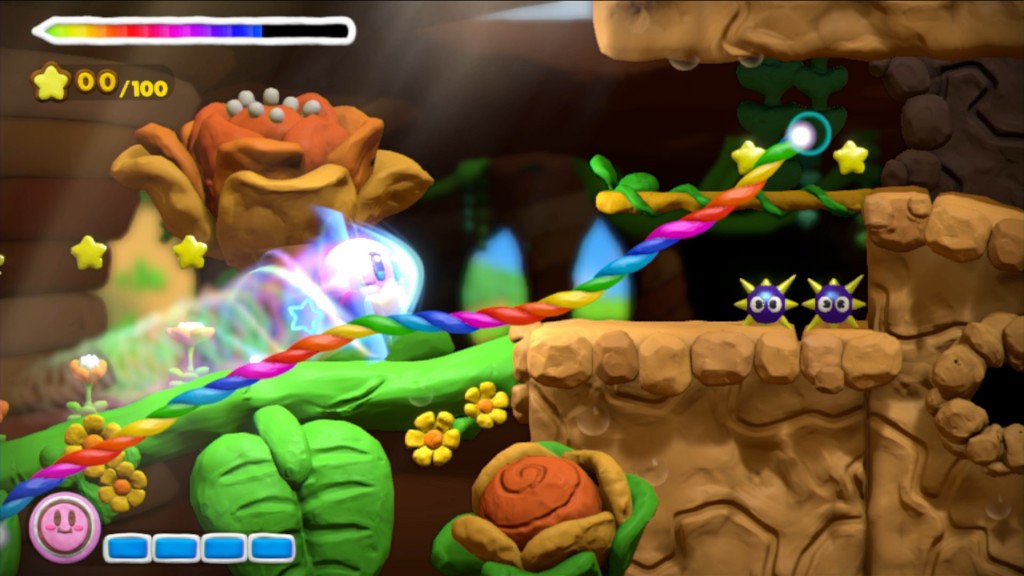
The Kirby series has a long history of experimentation. From Epic Yarn to Mass Attack, the pink puffball has been seen as Nintendo’s test subject for a multitude of crazy new ideas despite the series’ otherwise well-regarded formula. 2005 saw the release of Kirby Canvas Curse, considered by many to be the first great original Nintendo DS game and a fantastic new experimental take on a well-worn formula. It only took Nintendo ten years, but here we are with Kirby and the Rainbow Curse, a spiritual successor to Canvas Curse utilizing a new, unique art style. While it doesn’t stand up to the 2005 classic, Rainbow Curse still has plenty going for it.
As soon as you begin, you’ll immediately notice Rainbow Curse’s gorgeous claymation art style. Like Epic Yarn before it, this stylization of Kirby and his notorious foes stands out in a remarkable way. Not only is the attention to detail of each character amazing, the purposefully low-frame-rate animation adds a lot to an already-visually-charming game. If nothing else, you can’t deny Nintendo is masterful at finding new ways to create games which will aesthetically stand the test of time, and Rainbow Curse is no different.
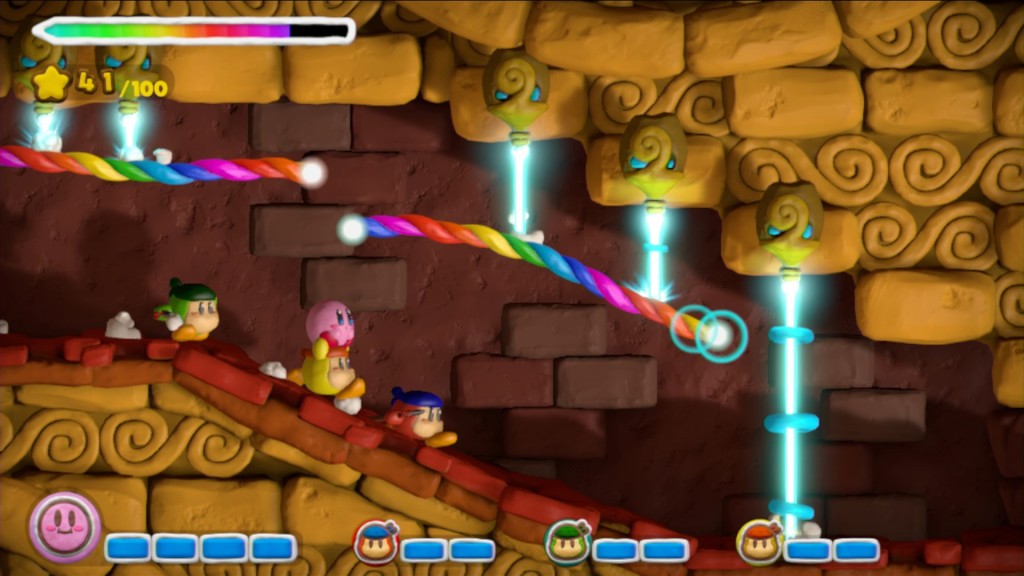
If you’ve played Canvas Curse before, you should know exactly what to expect here. Unlike traditional Kirby games, you have no real control over Kirby himself. Instead, you control the paint brush which draws lines on the screen in order to guide Kirby to where he needs to be, while occasionally tapping on Kirby to make him perform a dash attack. It won’t be long before you understand the basics of Rainbow Curse’s gameplay, but thanks to a steady difficulty ramp and some brilliant challenges, you’ll quickly see there’s more nuance to this seemingly simple game.
Controlling Kirby is itself a bit of a challenge, forcing you to think less about direct control of a character and more about how the lines you draw affect his movement. Not having direct control of a character is one thing, but knowing you have to force them to move in a very specific way, sometimes very quickly, without actually moving them directly is what separates Rainbow Curse from the rest of the series. The difficulty doesn’t ramp up until later levels, but the design of even the early levels quickly trains you on the specifics of line placement and how to best get Kirby to move where you want him to go. It’s a tricky, yet very rewarding core mechanic that feels just as satisfying here as it did ten years ago.
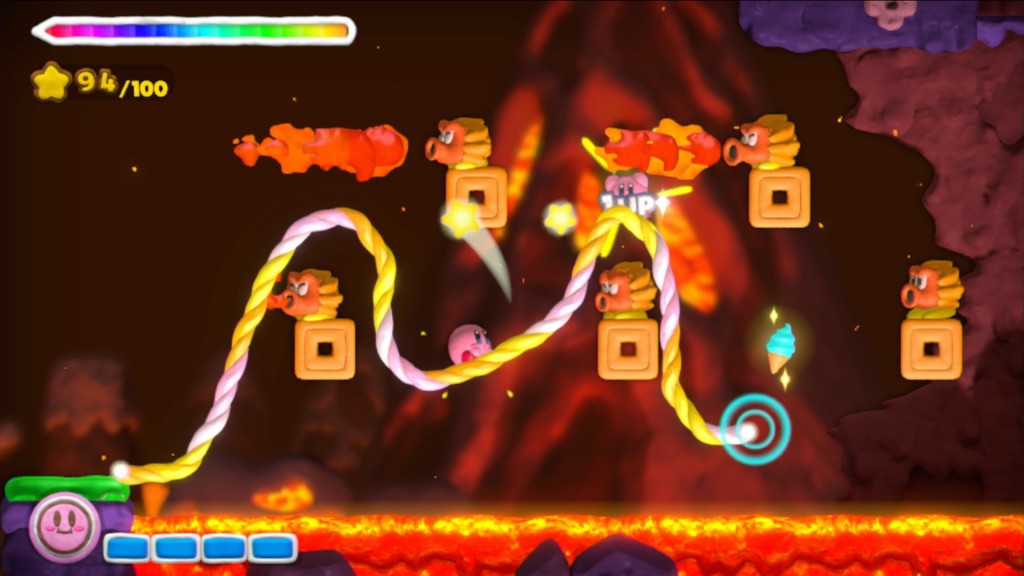
Localization touches
There’s a number of trophies (a la Smash Bros.) to collect, each with a witty description. Some descriptions simply describe the character in question in a simple summary, but others seem to play with expectations. Secret Diary entries, another collectible, are written and drawn in Elline’s perspective, chronicling her adventure with Kirby in Dream Land. – Eric Albuen
Eventually you’ll be drawing lines to move Kirby quickly from an enemy, to an item, to a secret and back to the main path without breaking a sweat. The gradual ramp up in challenge on top of the numerous bonus collectibles and secrets throughout each level provides you plenty of opportunities to test your skills while also slowly understanding the subtlety of the core mechanics. The formula is just as rewarding here as ever before.
The challenge levels are specifically designed to test your Rainbow Curse skills and became something I returned to long after the credits rolled. These challenges throw Kirby into a small area with a 15-second time limit and a single objective to complete, giving you a perfect opportunity to test your reflexes and understanding of the mechanics without much room for error. I found myself returning to these rooms several times simply because they boiled down the experience to its core mechanics and forced me to demonstrate everything I had learned up to that point to succeed. They were simple-but-effective ways to keep me coming back for more.
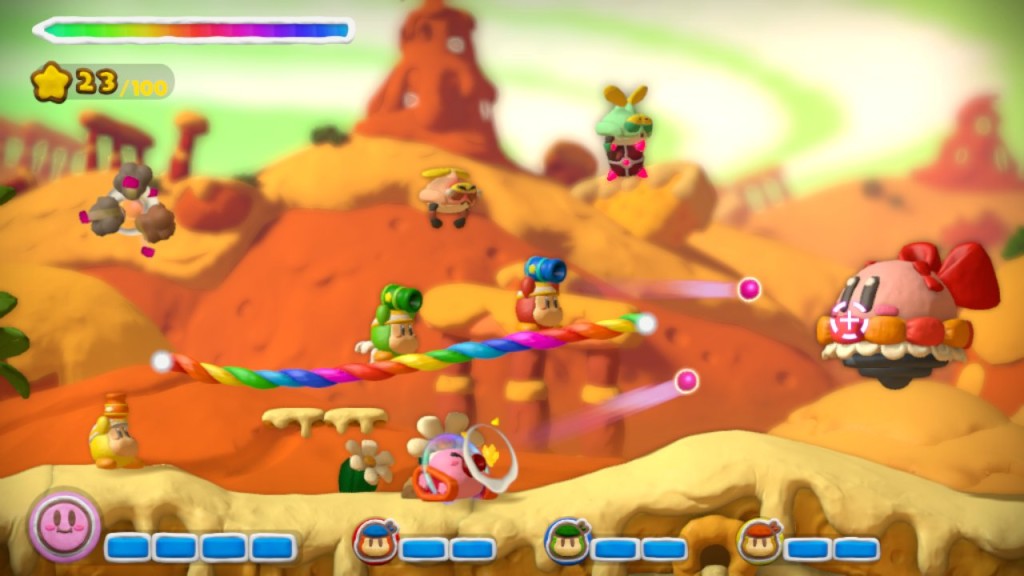
Curse‘s hybrid co-op
While player one’s focus remains on the GamePad, co-op partner Waddle Dees control like a traditional platformer. You can help Kirby conquer obstacles faster by carrying him places or even hitting certain switches and other intrusions for him for a smooth adventure. The game’s designed for touch controls first, so the platforming aspect can feel awkward at some points. – Eric Albuen
What Rainbow Curse lacks compared to Canvas Curse is variety. While the level design and variety of level types is excellent, there isn’t much separating one level from another in terms of the main mechanics. There are three transformations, each with their own specific control scheme. These mix things up well enough, yet they are repeated a few times throughout the game without much variety in the levels that utilize them. Even the boss fights, which truly test your skills in some exciting ways, are re-used and turned into slightly trickier, but ultimately similar, repeat fights.
My other big problem with Rainbow Curse is how you play it. Because this is a Wii U game that requires you to pay close attention to what lines you are drawing on the screen, you spend 95 percent of the time looking away from the TV. So much of what makes this game stand out is in its presentation, yet I was never able to fully appreciate it due to my inability to see it at its best the majority of the time. This is simply the nature of this style of game, which I understand, yet I sometimes wished I could be watching someone else play instead of actually playing just to see the incredible visuals in motion better. In a way, its a game hindered by its own gameplay and the Wii U itself.
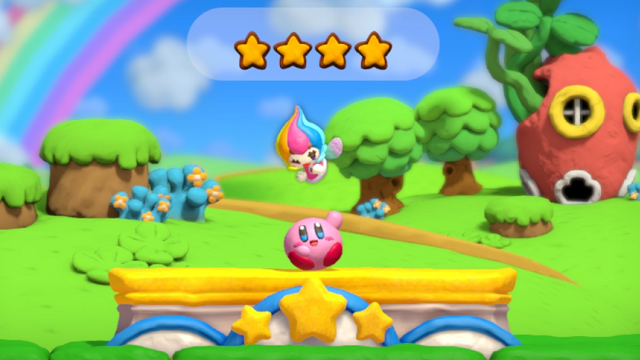
It may not live up to the high standards set by Canvas Curse almost a decade ago, but Kirby and the Rainbow Curse is still a fantastic experience that recaptures the spirit and core gameplay of the original. If you’re looking for a unique experience that stands out in a series full of them, you can’t go wrong here.
Pros: Gorgeous visuals, satisfying core mechanics, fun challenge rooms
Cons: Lack of variety, GamePad-focused play limits the experience



















